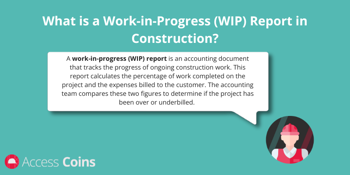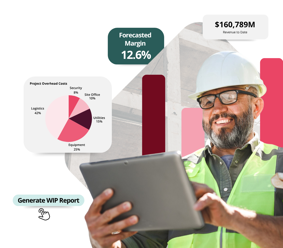Mastering Construction WIP Reports - A Guide for Construction CFOs
In construction, your WIP report is the heartbeat of your financial health. Get it wrong, and you risk cashflow gaps, profit fade, compliance issues even lost bonding capacity.
This guide breaks down why WIP reporting matters, the most common mistakes CFOs see, and how to build accurate, audit-ready reports that keep projects on-track.

What is a Work-in-Progress (WIP) Report in Construction?
A work-in-progress (WIP) report is an accounting document that tracks the progress of ongoing construction work. This report calculates the percentage of work completed on the project and the expenses billed to the customer. The accounting team compares these two figures to determine if the project has been over or underbilled.
Regular WIP reports are necessary to get a snapshot of an organization’s financial health on a project-by-project basis. With these reports, accounting teams can adjust billing appropriately to make sure expenses are covered and all stakeholders are on the same page. Since construction finances can change drastically over the course of a project, WIP reporting is necessary for accurate accounting and billing.
Why is WIP Construction Accounting Important?
Accurate Revenue Recognition
WIP reports ensure that your team has an accurate picture of your revenue at all times.
This helps you avoid over- or underbilling your clients, which can lead to long-term financial challenges. If you’re consistently underbilling, you won’t have the cash flow necessary to complete the project. This can result in project delays or even unnecessary debt.
Frequent overbilling can erode trust with your clients and harm your reputation. If occasional overbilling happens, it should be treated as advance cash flow rather than profit. This helps avoid accounting errors down the road.
Additionally, WIP reports are necessary for maintaining compliance with ASC 606 and IFRS 15. These are two key revenue recognition standards that accounting teams need to adhere to. If non-compliance with ASC 606 or IFRS 15 are uncovered during an audit, it could lead to significant reputational damage and a loss of investor confidence. Even a small error could harm your business and negatively impact future construction projects.
Proactive Risk Management
WIP reports help your team identify possible problems before they happen. This gives you time to re-evaluate your construction strategy and prevent losses.
For example, you might notice early in a project that costs are rising far beyond initial estimates or that the project will be significantly delayed. These issues can happen for a number of reasons, including unexpected weather events, spikes in material costs, or a fluctuating labor market.
Frequent WIP reports help you catch these issues quickly. This way, your project managers can work with your finance team and your external stakeholders to redirect the project and make it more financially sustainable.
Cash Flow Management
Cash flow gaps are a significant challenge for construction organizations. One study found that 43% of subcontractors don’t have enough working capital to cover unexpected expenses or project delays. When your business is struggling with cash flow, veering even slightly from your initial estimates could throw off your finances.
WIP reports help your business manage cash flow more efficiently. Over time, you’ll determine how to optimize billing cycles based on the pace of each project, so you’re not struggling with frustrating cash flow gaps. Ideally, you should have the cash flow necessary to cover unexpected expenses, without consistently overbilling your clients.
Informed Decision-Making & Strategic Planning
Accurate WIP reports help you understand how financially viable each project is. You’ll identify which project types are consistently profitable and which ones require more efficient operations.
This information can guide future bidding strategies. For example, if your WIP reports indicate that you’re consistently underbilling, you can increase future project bids to avoid taking on more debt.
WIP reports can also inform your capital allocation decisions. You might find that you’re consistently spending more than estimated on labor or materials, you can reallocate your budget so you’re correctly estimating project spend every time.
Improved Bonding Capacity & Lender Confidence
Building strong relationships with lenders and investors is necessary for success in the construction industry. To get financing for future projects, you’ll need to demonstrate financial stability and accurate reporting capabilities to these external stakeholders.
WIP reports help you build trust and bolster your reputation when applying for financing. Some lenders or investors may even require WIP reports from past projects during the financing process. Delivering accurate WIP reports every time can help you stand out from the competition and attract larger sums of funding, ultimately leading to more financial flexibility.
Common Mistakes in WIP Reporting
While accurate WIP reports are essential for construction success, many teams make errors that result in inaccurate accounting and cash flow issues later on. Here are some of the most common mistakes that construction teams make when generating WIP reports and what you can do to prevent them.
The most common mistakes in WIP reporting are -
- Outdated data
- Manual data entry mistakes
- Siloed data sources
- Inaccurate cost allocations
- Failure to capture real-time costs
- Disconnect between field and office
- Inconsistent reporting
Relying on Outdated or Manual Data Entry
Many construction teams still rely on manually-updated spreadsheets to keep track of inventory levels, labor costs and other essential data. This approach is prone to human error, and spreadsheets aren’t always updated on time.
Disconnected Data Sources
Alternatively, some construction teams rely on a stack of unintegrated software programs to manage data. For example, you might use one software program for accounting, another for supply chain management and another for engineering and project management. The result is disparate, inconsistent data that isn’t always accurate.
When you’re using outdated systems, it becomes very difficult to create an accurate WIP report. Reconciling data across multiple files and platforms is a time-consuming process, so by the time you’ve generated your report, the information will be outdated.
Inaccurate Cost Allocation & Tracking
Detailed cost allocation is an essential part of any WIP report. Each of these reports should include a breakdown of all direct and indirect expenses incurred by the project so far, as well as a comparison of actual vs. estimated expenses. This information is necessary to calculate the percentage of project completion and accurately bill clients.
However, many teams struggle with inaccurate cost allocation when creating WIP reports. If you overlook or misclassify costs, you will not be able to accurately calculate project completion levels or estimate project profitability. Over time, these inaccuracies can erode client trust and lead to uninformed financial decisions.
Lack of Real-Time Visibility
In order to generate accurate WIP reports and avoid accounting errors, you need access to construction data in real time. However, if you’re updating your systems manually, you might find that data doesn’t get updated until days or even weeks after the fact.
If you’re making decisions based on outdated information, you won’t be able to course-correct if projects start spiralling out of control. You might not realize you’re running behind or over budget until weeks after the problem starts, so you won’t be able to take any preventative action. Switching to a system that offers real-time data collection and management will help you intervene faster when problems start.
Disconnect Between Field & Office
To keep your construction operations running smoothly, your field teams need to be communicating with your office as they work. A strong relationship between these two teams is essential for full transparency and preventing errors.
Unfortunately, many construction companies don’t have the technology or processes in place to support open communication between field and office teams. When your project managers aren’t sharing data with accounting, it leads to discrepancies between the actual work performed and the work recorded in WIP reports.
To prevent this from happening, your field and office teams need to use integrated data management solutions. Centralizing your data helps avoid frustrating miscommunications.
Inconsistent Reporting Methodologies
In large organizations, there are sometimes inconsistencies in how WIP figures are calculated. For example, different people might use different formulas to calculate project completion percentages.
These inconsistencies make it difficult to compare data across projects and identify trends. To prevent this from happening, accounting teams should establish a standard methodology for calculating and formatting WIP reports so they are consistent across every project.

How an Integrated ERP Platform Transforms Construction WIP Accounting
Data silos, outdated or inaccurate reporting and manual systems are all problems that hold construction teams back from effective WIP accounting. One of the easiest ways to solve these problems and create WIP reports for construction is by using an integrated ERP platform. Construction-focused ERP software helps you manage data from across your operations all in one place.
Instead of using separate technology for project management, accounting, supply chain management, and labor management, everything is done in one convenient system. This helps teams generate consistent, accurate WIP reports without the hassle.
Here’s how integrated ERP platforms make WIP accounting faster, easier, and more accurate.
Real-Time Data Integration
ERPs are designed to collect construction data in real time. Instead of having your employees manually enter data in spreadsheets, the ERP captures it instantly.
All project costs, including labor, subcontractors, materials and equipment, are captured as soon as they happen. This real-time integration means that your accounting team can use up-to-the-minute data for WIP calculations, resulting in more accurate completion percentage figures and billing costs.
Automated Cost Allocation & Tracking
ERPs use automation to make construction accounting faster and more accurate. You can configure your ERP systems to automate expense categorization and job costing based on your operations. Not only does this make accounting much faster, it also eliminates human error and ensures consistency between projects.
Dynamic WIP Reporting & Dashboards
Access’s construction-focused ERP offers detailed, customizable reports and dashboards, giving all key stakeholders visibility into project performance and financials. Dashboards help you visualize real-time project performance at a glance. They also provide data-driven insights that will help your team take action faster.
Extensive reporting options can be tailored to meet your needs and preferences. For example, you can compare projected vs. actual expenses and conduct variance analysis to see where these discrepancies come from.
Enhanced Collaboration & Transparency
ERPs create a single source of truth for your entire department, which helps eliminate data silos between departments. This makes it easier for everyone involved to collaborate on WIP reporting. The accounting team can quickly access supply chain data or labor data when generating reports, and project managers have access to financial data to support more proactive decision-making.
Predictive Analytics & Forecasting
One of the most valuable features that ERP construction platforms offer is predictive analytics. The ERP compares historical data with real-time inputs to help you forecast project outcomes. For example, the platform can identify that a project is going over budget before it happens, giving you the chance to course-correct. These features help your entire team operate in a more agile manner.
Ready to see how easy WIP reporting can be?
Stop wrestling with spreadsheets and start building accurate, realtime WIP reports that keep your projects, cash flow and compliance on track.
Watch our 4 minute Access Coins demo to see how integrated job costing, AIA billing, and automated WIP dashboards work together to give CFOs total visibility and control.

 UK
UK
 AU & NZ
AU & NZ
 SG
SG
 MY
MY
 IE
IE







